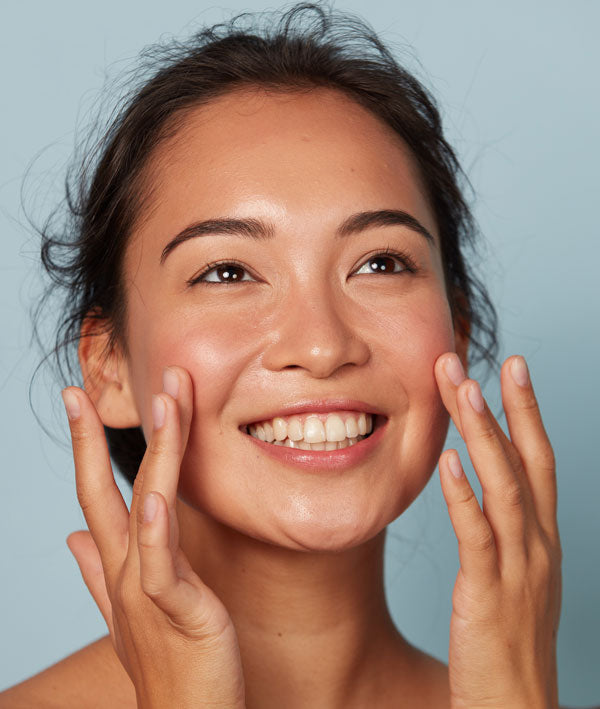There’s nothing more frustrating than getting to the end of your beauty routine and realizing the products on your face are starting to pill. If you’ve been dealing with pilling, we’re here to break down the top steps you can take to stop skincare and makeup pilling for good.
What Causes Makeup to Pill?
Pilling on the skin occurs when makeup (or the skincare products underneath) starts to ball up. This is most noticeable when you touch your skin and feel small gritty pieces forming under your fingertips.
A variety of different factors can lead to pilling. This includes (but is not limited to) improper skincare application, over applying certain products, and using formulas that don’t play well together.
Unfortunately, there’s little you can do to stop makeup and skincare pilling once it has started – beyond washing your face and starting over. This is why it’s so important to implement steps to reduce your risk of pilling.
How to Avoid Makeup and Skincare Pilling
If you’re ready to be done with makeup and skincare pilling for good, here are our top tips for properly preparing your complexion for a smooth, flawless finish.
1. Let Your Products Fully Absorb
While many of us want to get through our skincare routine as quickly as possible, having a little bit of patience can help prevent pilling. Your toners,face serums, and moisturizer all need time to properly absorb into the skin, and moving on to the next step too quickly can hinder the absorption process. When we don’t allow each product to set into the skin, the extra residue can cause certain skincare products and makeup to pill. For the best results, give at least a minute between applying each product – it can make a world of difference!
2. Apply Your Skincare in the Right Order
Many are surprised to learn that there’s a wrong order to apply their skincare. When applying your products, it’s best to follow the thinnest to thickest rule. This allows the lighter formulas to better absorb into the skin – which, as we now know, is essential for creating a smooth canvas on the skin. This not only reduces the risk of pilling, but also increases the effectiveness of your products.
As an example, let’s say you have a lighter serum, such ashyaluronic acid, as well as a more creamy serum. You’ll first apply the lighter serum after cleansing, and then follow up with the richer serum. You can then apply your moisturizer, and your sunscreen after that during the day. As noted above, be sure to allow at least a minute between the application of each product. You’ll be free of pilling all day long!
3. Avoid Too Much Product
On a similar note, you also increase your risk of experiencing pilling if you apply too much of a certain product. When an excess is applied, some of the product won’t be able to fully penetrate into the skin. Instead, it sits on the surface of the face, creating an extra layer of residue that can lead to pilling. This also means that you’re wasting product – a less is more approach is better on all accounts.
4. Make Sure Products are Compatible
Some skincare and makeup products simply don’t layer well together. One of the biggest examples is combining oil-based withwater-based products. These types of formulas repel each other when combined, as oil and water don't mix. The result? Pilling and uneven makeup application. Look at the ingredients lists of the products you are using, and see if they are compatible. This is especially important to consider when it comes to moisturizers, sunscreens, foundations, and tinted moisturizers.
Additionally, certain ingredients – including mica, talc, silicones, and iron oxides – have a higher risk of pilling on the skin. If you’re using multiple formulas containing one or more of these ingredients, there’s a good chance they’ll pill.
5. Use Lightweight Formulas
If you’re still experiencing pilling, it might mean that the skincare and makeup products that you are using are too rich. Thicker formulas may not fully absorb, leaving a residue on the surface of the skin. This extra layer of product can be especially problematic when trying to apply makeup.
Take a look at the skincare and makeup formulas you are using, and see if any of them are on the richer side. Consider swapping them out for lighter alternatives that will more easily absorb into the skin, and see how it affects your skincare and makeup routine.
6. Exfoliate Often
Last but certainly not least, it’s essential that you are regularly exfoliating your skin. Exfoliating – either with a chemical exfoliant or a physical scrub – works to get rid of the build up of dead skin cells and other debris on the surface of the skin. When not regularly cleared away, this buildup can create texture on the skin and create pilling. For a super smooth canvas, be sure to exfoliate around one to two times per week (or more often, depending on the product you’re using).
Other Tips to Avoid Skincare and Makeup Pilling
Choose the Right Primer
Using a primer before applying makeup can create a smooth base and help prevent pilling. Opt for a primer that suits your skin type and works well with your skincare products. Silicone-based primers are great for filling in fine lines and creating a smooth canvas, while water-based primers are ideal for those with oily skin. Make sure to let the primer fully set before applying foundation to avoid any pilling.
Patch Test New Products
Before incorporating new skincare or makeup products into your routine, conduct a patch test. Apply a small amount of the product on your jawline or the back of your hand and wait for at least 24 hours. This will help you determine if the product will cause pilling or any adverse reactions. By patch testing, you can ensure that all your products work harmoniously together without disrupting your skincare and makeup routine.







